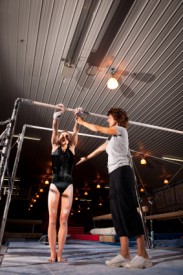
Consider for a moment an athlete’s body, let’s say, a gymnast’s form. Not only does she have a highly trained musculature, but maybe more importantly, through her years of training, she has developed a greater ability to coordinate her physical movements. In the same way that her muscles have become stronger through physical training, her nervous system—via
brain plasticityand the ability of the brain to grow and adapt based on stimuli—has likewise become more able to efficiently respond to the demands she is placing upon her mind and body.
For years, researchers have been investigating how the brain interfaces with the body in an effort to decipher the electrical language of mind. Research like that of
Dr. Miguel Nicolelisat Duke University Medical Center has demonstrated that this language can be understood and harnessed to do things like power robotic prosthetics.
However controversial you might consider his work, Dr. Nicolelis’s discoveries are nothing short of—pardon the phrase—mind-bending, and are directly relevant to our talk about brain plasticity. In brief, Dr. Nicolelis’s recent research has focused on working with a rhesus monkey named Aurora. In short, through implants in her skull, Nicolelis was able to record Aurora’s motor nerve signals as she used a joystick to play a simple video game. He then used a computer algorithm to convert those signals into code to power a robotic arm. This led to two results.
First, as Aurora observed her own motions mimicked in the movements of the robotic arm, she began to be able to control the movements of the robot with her thoughts, and was able to use it to successfully manipulate the robotic arm to play the video game. What’s more, she figured out that she could control the robotic arm with her thoughts alone and
without having to move her own arm and began to do so spontaneously.(See
this article from
Scientific American
for detail, or read an excerpt about Aurora from Nicolelis’s book,
Beyond Boundaries: The New Neuroscience of Connecting Brains with Machines and How it Will Change Our Lives
.)
Likewise, this same ability has been documented in humans. Researchers at the University of Washington mapped signals from the surface of human subjects’ brains and harnessed them to control the movement of a computer cursor on a screen. With only ten minutes of training, subjects were able to figure out how to move the cursor using their minds alone. Maybe more importantly, “brain signals from imagined movement became significantly stronger than when actually performing the physical motion.”
[i]
According to Rajesh Rao, a UW associate professor of computer science and engineering, “the rapid augmentation of activity during this type of learning bears testimony to the remarkable plasticity of the brain as it learns to control a non-biological device.”
[ii]
Because of brain plasticity and the ability of the mind to quickly adapt to such situations and deliver stronger signals through such training, robotic prosthetics that directly respond to thought are almost in humanity’s grasp; we’re beyond the phase of discovery and are now into the fine tuning to make the innovation truly useful. While such developments may not allow a paraplegic to jump out of a wheelchair and turn summersaults next week like our gymnast, the simple ability that so many of us take for granted, such as walking across a room, might be available within our lifetime.
[i] Brain-Controlled Cursor Doubles as a Neural Workout. ScienceDaily. February 16, 2010.
[ii]Ibid.
For further reading:
- Brain Controlled Cursor Doubles as a Neural Workout. ScienceDaily. Feb. 16, 2010.
- Mindful Motion: Miguel Nicolelis and Mind-Powered Robots; and Creating Science Cities in Brazil and Beyond. Scientific American. January 16, 2008.
- Beyond Boundaries: The New Neuroscience of Connecting Brains with Machines and How it Will Change Our Lives .Miguel Nicolelis. 2011. (Excerpt only.)
Related Reading:

